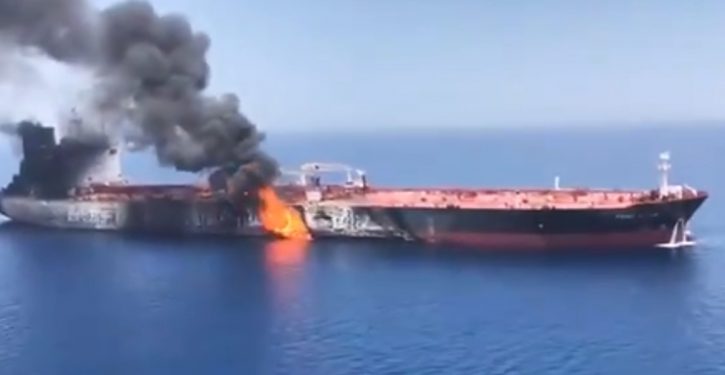
UPDATE at bottom of text
There’s a lot of detail lacking on Thursday’s attacks in the Gulf of Oman on two oil tankers. In the interest of getting a post up, I won’t wait for further clarification at this point, but run with what we’ve got.
What we’ve got indicates that this pair of attacks is an escalation from the attacks in May on four tankers off the coast of UAE. Those tankers were at anchor or at least operating close to shore at very low speeds, and could reasonably have been attacked with limpet mines placed shortly before holes were blown at their water lines. The flag nations concluded afterward that that was the type of attack, with divers having been used to place the mines on the tankers’ hulls.
Will this presidential election be the most important in American history?
The attacks on Thursday 13 June were on ships in transit in the center of the Gulf of Oman. Both had recently exited the Persian Gulf, and presumably were at transit speeds between 12 and 15 knots (nautical miles per hour).
Earlier this morning, two #tankers, #FrontAltair & #Kokuka Courageous, were reportedly torpedoed off the coast of #Oman. Watch their final movements before the reported #incidents in this past track video and learn more here: https://t.co/Odj8NYkkSm #marinetraffic pic.twitter.com/78XRuBorut
— MarineTraffic (@MarineTraffic) June 13, 2019
Aegis destroyer USS Bainbridge (DDG-96), which responded to distress calls from the tankers, reportedly observed a limpet mine on the hull of yet another ship. But it’s very unlikely mines were placed while the tankers were at transit speed. Limpet mines can be command detonated or set with timers; the one seen by the crew of the Bainbridge had probably been attached sometime earlier.
Both of the known damaged ships had left port within the last 72 hours.
Meanwhile, the reporting on the nature of the attacks suggests that one of the tankers was “fired on” with “projectiles.” I stress that initial reports aren’t always reliable, and commercial ships don’t routinely have observers watching – in every direction around the ship – as closely as naval warships do. That said, the ship in question, Kokuka Courageous, according to shipping company Kokuka Sangyo, reported coming under fire multiple times in the Thursday incident.
Panama-flagged Kokuka Courageous, which left Al Jubail, Saudi Arabia on 10 June carrying a cargo of methanol destined for Singapore, said it was fired on in the Gulf of Oman and “made evasive manoeuvers but three hours later it was hit again.”
The Wall Street Journal report characterized it this way: the “Japanese tanker … was hit with a projectile in a series of assaults, Japanese officials said.”
A “projectile” would ordinarily be interpreted as something flying through the air. A rocket would be an obvious culprit based on Iran’s known history of training and proficiency, although the accuracy of landing multiple rocket hits as apparently reported by Kokuka Courageous would be a bit surprising.
The launch platform for rockets in this scenario would have to have been close enough to Kokuka Courageous for the ship to be well aware of where the projectiles were coming from. If that was the case, we haven’t been accorded the information to understand that about the incident.
Bainbridge, which responded to Kokuka Courageous and rescued 21 crewmembers, would probably have been aware of it as well. It may be that there’s simply information that hasn’t been reported to the public yet.

Another possibility might theoretically be antiship cruise missiles launched from shore. But the geometry is off for that scenario. The damage to Kokuka Courageous was reported to be on the wrong side of the ship: the starboard side (like the other ship, Front Altair), which in an outbound transit would be facing away from the coast of Iran.

However, Iran does have the option of a new cruise missile launched from a midget submarine. The Iranians reportedly demonstrated the capability in February 2019 in a major naval exercise, launching a cruise missile developed in the Jask-2 program – an Iranian version of the Chinese C-704 antiship cruise missile – from a Ghadir-class midget sub. The range of the latest indigenous C-704 version isn’t known in public sources, but the Iranians say it’s greater than the 20 nautical miles (about 25 statute miles, or 38 km) of the earlier Nasr-1. It’s possible the cruise missile could have been launched by a midget sub from beyond line of sight, in other words.


For those speculating that another actor is trying to pin this on Iran, cruise missiles coming from the opposite coast are very unlikely here. The tanker would have been one of many passing through the same area in the Gulf of Oman, and in such a situation, it would be especially unlikely for missiles launched from the opposite shore to keep finding and hitting Kokuka Courageous. The ship may have been selected at random, but multiple hits or very near misses on the same tanker in heavy strait traffic, from across the heaviest of the traffic, are improbable. Someone else was likely to take a hit in such a case.
No one did. The other tanker, Front Altair, was too far away to be affected by the same targeting attempt. Front Altair, a Norwegian-owned, Marshall Islands-flagged tanker carrying naphtha, reported a “torpedo” hit, according to the Taiwanese refiner that chartered the cargo for transport. That report is backed up by the master of a nearby vessel that rendered assistance, the Hyundai Dubai:
The skipper of the Hyundai Dubai, a ship giving assistance to the Front Altair, relayed in a distress call that the skipper of the stricken ship believed the incident to be “most probably torpedo attack, torpedo attack,” according to a recording of the call.
M.T Front Altair has been abandoned and its all crew has been safely picked up by nearest vessel Hyundai Dubai.
Master of Hyundai Dubai reported cause of fire on Front Altair as surface attack.
Front Altair is a loaded tanker on fire and adrift about 18 NM off our position. pic.twitter.com/QNuSbQF95b
— Maya Al Amri/قابوس (@maya_alamri2) June 13, 2019
The damage to Front Altair was reported by another ship on scene to be below the water line and consistent with a torpedo attack.
Front Altair had departed the Emirati port of Ruwais on Tuesday headed for Kaohsiung with her load of naphtha. It hasn’t been specified yet what ship Bainbridge saw the limpet mine on, but if the radio updates I’m hearing are correct, the mine was seen on a third, so far unnamed ship, and not one of the two that suffered known damage.
The escalation here is the increasing sophistication and tactical agility of the attacks. I’m not prepared to come down firmly for any scenario (although I think a cruise-missile-from-shore option is the least likely). It may be that an effect much like coming under attack from moving projectiles was achieved by attaching limpet mines and then detonating them in conjunction with projectile-lobbing. It may be that at least one of the ships was hit, in fact, by airborne projectiles.
It’s not out of the question that Front Altair was hit with a torpedo. Iran has that capability, certainly, using the midget submarines homeported just outside the Strait of Hormuz (in the naval base at Bandar-e-Jask). A pair of midget subs with some coordinated targeting assistance (from dhows operating in faceless anonymity, for all we know) could have brought off both attacks.

The bottom line is that this is a ramp-up. International shipping is going to respond with much greater anxiety this time. Mike Pompeo is quoted as follows:
Mr. Pompeo said the latest U.S. assessment is based on “intelligence, the weapons used, the level of expertise needed to execute the operation, recent similar Iranian attacks on shipping, and the fact that no proxy group operating in the area has the resources and proficiency to act with such a high degree of sophistication.”
It is the assessment of the U.S. government that Iran is responsible for today's attacks in the Gulf of Oman. These attacks are a threat to international peace and security, a blatant assault on the freedom of navigation, and an unacceptable escalation of tension by Iran. pic.twitter.com/cbLrWNU5S0
— Secretary Pompeo (@SecPompeo) June 13, 2019
Two more points. One, as several of the reports on the attacks have noted, Houthi rebels on Wednesday 12 June attacked Abha airport in southern Saudi Arabia with a missile launched from Yemen, injuring 26 civilians. The timing-proximity of this attack to the tanker attacks on Thursday is similar to the near-coincident attacks in May on the four tankers off UAE and the pipeline in Saudi Arabia.
Two, another feature that was erupting around the time of the May tanker attacks has also recurred, if at a much lower level. Rocket launches resumed this week from Gaza on the civilian population of Israel. The pattern from May is being echoed, suggesting Iran’s hand behind a region-wide effort.
A final note. USS Bainbridge and Hyundai Dubai were the ships on-scene evacuating the crews from Kokuka Courageous and Front Altair. Iran later accepted 23 crewmembers from Front Altair for transport to the port of Jask in southern Iran. Reporting from Iran and Russia Today turned that Iranian service into Iran rescuing all “44 crew members of oil tankers” after the attacks. Heroic-sounding, but I’ll take Bainbridge’s word on this one.
*UPDATE* Reported just prior to going to post on this: U.S. reportedly has video of an IRGC vessel’s crew removing “an unexploded limpet mine from the side of a Japanese tanker attacked on Thursday in the Gulf of Oman,” according to a Reuters story carried by Jerusalem Post. The story was sourced to an unnamed U.S. official. It’s not clear what that means about the nature of the attack, but does cloud the issue of how it was brought off. Assuming the “Japanese tanker” was Kokuka Courageous, this would probably indicate the ship Bainbridge saw the mine attached to was the same one, rather than a third vessel as reported several times in ABC News updates on the radio on Thursday. Possible viewing platforms on the U.S. Navy side include Bainbridge, a helicopter from Bainbridge, and the Navy P-8 Poseidon surveillance aircraft that responded to the scene. More to follow if there are updates to this story.




